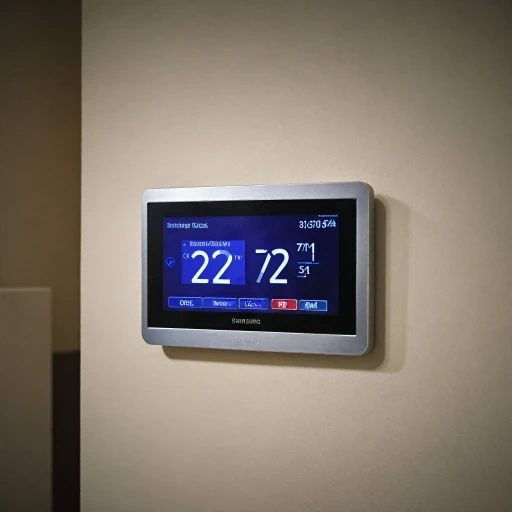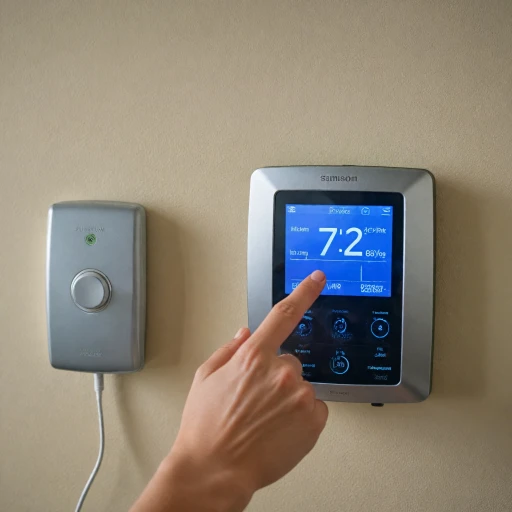Understanding the Basics of Smart Thermostats
Exploring Smart Thermostats for Home Efficiency
Smart thermostats have revolutionized home climate control, offering not just convenience but also significant energy savings. In essence, these devices enable homeowners to manage heating and cooling systems more efficiently, adapting to individual preferences and schedules. The integration of cutting-edge technology allows smart thermostats to learn user patterns and adjust settings automatically. Understanding the impact of temperature regulation in different parts of your home, such as the attic, is crucial. Attics often trap excessive heat, making them a focal point when considering energy efficiency solutions. This is where smart thermostats partnered with attic fans play a pivotal role.- Temperature Monitoring: Smart thermostats are equipped with sensors that monitor indoor air temperature, reacting to changes in the environment. When connected to an attic fan, which typically operates as an exhaust fan, they can help maintain optimal thermal conditions by expelling hot air.
- Energy Management: By integrating attic fans with thermostats, you can achieve better energy efficiency. This duo ensures that energy is used effectively, reducing unnecessary power consumption and lowering your energy bills. Solar power options for attic fans further enhance this efficiency, utilizing renewable energy to reduce your carbon footprint.
- Versatile Products: From gable mount attic fans to roof mount power attic fans, homeowners have a variety of products to choose from. Adjustable thermostats can effectively manage different fan types, such as cfm gable or maxx air ventilation fans, tailoring operation to meet specific needs.
The Functionality of an Attic Fan with Thermostat
Exploring the Role and Efficiency of Attic Fans with Thermostats
When it comes to maintaining an ideal temperature within the home, incorporating an attic fan with a thermostat can be an effective method. This setup is not only about cooling down your attic; it plays a crucial part in enhancing your home’s overall climate control system. Attic fans equipped with thermostats are designed to automatically regulate the temperature in the attic space. These fans are typically installed on gable mounts or roof mounts, offering a strategic location for optimized air circulation. Devices like a solar power attic fan capitalize on solar energy, promoting energy efficiency while providing adequate attic ventilation with minimal environmental impact. The primary function of these fans is to exhaust hot air trapped in the attic, essentially turning the attic into an effective ventilation vent. This process can significantly reduce the heat load on the rest of the home, potentially lowering cooling costs. Products from reputed manufacturers, such as Maxx Air and Master Flow, are known for their reliable motor performance and innovative designs. One of the critical benefits of using a fan with an adjustable thermostat is the capability to customize the temperature settings. This adjustable feature allows homeowners to set specific temperatures at which the fan operates, ensuring optimal attic airflow. The product's cfm rating (cubic feet per minute) is an important consideration, as it determines the volumetric flow rate of the exhaust fan, influencing how quickly hot air is expelled from the attic. In terms of installation considerations, it's vital to assess whether a gable mount or roof mount power attic fan best suits the structure of the home. Solar attic fans are a popular choice due to their energy efficiency and relatively easy installation process. However, when installing any attic ventilator, factors such as cfm requirements, available roof space, and proximity to direct sunlight for solar-powered models must be contemplated. Ultimately, a smart thermostat connected to an attic fan can streamline the synergy between these devices, automatically optimizing energy use and boosting your home's energy efficiency. This integration underscores the importance of adjusting to future trends in smart home climate control, where efficiency meets intelligent automation.Benefits of Integrating Smart Thermostats with Attic Fans
Integrating Attic Fans with Smart Thermostats
By leveraging the capabilities of smart thermostats, integrating them with attic fans can significantly enhance home comfort and energy efficiency. Combining these technologies allows precise control of temperature and ventilation, which can contribute to lowering cooling costs. Here’s how integrating smart thermostats with attic ventilation systems can benefit your home:
- Energy Efficiency: When the temperature in your attic rises, an attic fan equipped with a thermostat can automatically activate to vent hot air, thus reducing the need for air conditioning. This system helps maintain a moderate attic temperature, enhancing energy efficiency across your home.
- Optimized Airflow: Ventilation fans, such as those with gable or roof mounts, work with thermostats to circulate cooler air into the home’s attic. Using a fan with adjustable thermostat settings can optimize airflow, preventing hot air from accumulating under the roof and improving overall attic ventilation.
- Intelligent Synchronization: Smart thermostats allow homeowners to sync attic fans with other HVAC systems. This ensures that all systems work harmoniously, further refining energy consumption and climate control in homes. By setting specific temperature thresholds, these thermostats instruct attic fans to engage only when necessary, boosting efficiency.
- Cost Savings: Implementing a smart thermostat with an attic ventilator, such as a solar attic fan or a maxx air power attic fan, can result in considerable cost savings. Smart control reduces unnecessary fan operation, leading to lower energy bills.
Integrating a smart thermostat with your attic ventilation system offers a strategic advantage for maintaining your home's environment effectively. Not only does it keep the temperature in check, but it also aligns with energy-saving goals, creating a win-win situation for homeowners.
Installation Considerations for Attic Fans with Thermostats
Getting Started with Attic Fan Installation
Installing an attic fan with a thermostat can significantly enhance your attic ventilation system, helping to maintain the right temperature and improve energy efficiency in your home. When you're planning to install an attic fan, it's crucial to consider several key factors to ensure the product is both efficient and effective.Selecting the Appropriate Type
- Roof Mount vs. Gable Mount: Decide whether a roof mount or a gable mount is best suited for your home's architecture. Roof mount fans are ideal if you have accessible attic vents, while gable mount options can be more practical if your home has gable ends.
- Solar or Electric Power: Consider the energy source. Solar attic fans represent an eco-friendly choice that operates without additional energy costs, whereas electric fans offer consistent performance regardless of sunlight availability.
Ensuring Proper CFM Rating
Determine the appropriate cubic feet per minute (CFM) rating for your attic vent. It should ideally handle the air volume of your attic space effectively, maximizing the exhaust capabilities. A cfm gable or roof fan with a suitable CFM rating ensures optimal air exchange.Selecting Adjustable Thermostat Options
An adjustable thermostat can be key to maximizing the effectiveness of attic fans. It ensures your exhaust fan operates only when necessary, maintaining comfortable temperature levels. Master Flow and Maxx Air offer products with adjustable settings, increasing energy efficiency and reducing wear on the motor.Professional vs. DIY Installation
Professional installation can guarantee optimal placement and functionality, reducing potential issues with wiring and mounts. However, if you prefer a DIY approach, ensure thorough research and follow manufacturer guidelines to mitigate potential challenges that may arise.Consider Additional Features for Enhanced Functionality
Some attic fans offer extra options, such as temperature sensors and controls for precise ventilation adjustments. These can be helpful if you want specific temperature settings catered for, improving your overall home comfort and energy savings.Assessing Shipping Rates and Availability
When purchasing your fan, consider the shipping rates and availability from the chosen supplier. Some may offer free shipping on certain products, which can be cost-effective and convenient. By incorporating these considerations into your installation plan, you can ensure your attic fan with a thermostat operates effectively and contributes to maintaining a stable climate comfort throughout your home.Common Challenges and Solutions
Addressing Common Challenges with Smart Thermostat-Equipped Attic Fans
Integrating a smart thermostat with your attic fan can greatly improve your home's comfort and energy efficiency. However, there are some challenges that homeowners might face during the process. Addressing these challenges effectively ensures a seamless operation:- Proper Placement and Installation: Ensuring the right placement of your attic fan, whether it's a roof mount or gable mount, is crucial. Consider the attic's design and ventilation needs when deciding on the location. Proper installation is vital for optimal air flow and the fan’s performance; poor placement can lead to inadequate ventilation, leaving areas of your attic too hot or too cold.
- Adjustable Temperature Settings: A common issue can be setting the right temperature on your thermostat. Ensure that your adjustable thermostat allows you to program the ideal temperatures that account for both energy efficiency and comfort. This is essential to prevent the exhaust fan from running unnecessarily, which could increase energy consumption.
- Power Source Compatibility: If opting for a solar attic fan, ensure your solar setup is sufficient to power your attic ventilator consistently. Solar power products are fantastic for energy efficiency, but they require adequate sunlight to function effectively.
- Ventilation Capacity: The cubic feet per minute (CFM) rating of fans is a key factor. Choose a fan with a CFM gable that matches the size and specific needs of your attic. Master Flow and Maxx Air are some of the notable products known for their efficient performance.
- Dealing with Motor Issues: Over time, motors can exhibit wear and tear, impacting the operation of the exhaust fan. Routine maintenance can prevent these issues. Replacement parts for trusted products should be readily available to minimize downtime.





